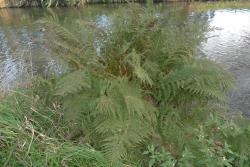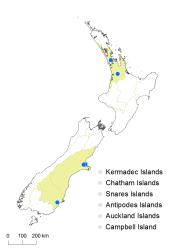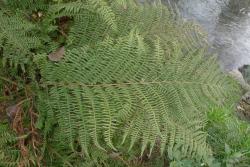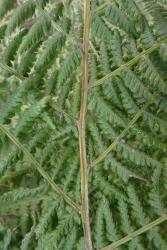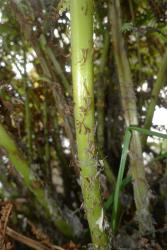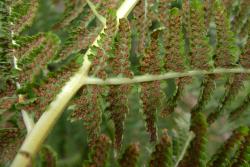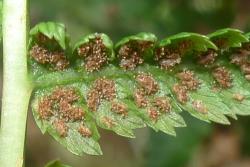- ≡ Polypodium filix-femina L., Sp. Pl. 1090 (1753)
Rhizomes erect, sometimes forming short woody trunks; bearing scales. Rhizome scales narrowly ovate, 8–12 mm long, 3–4 mm wide, chestnut-brown to dark brown. Fronds 260–950 mm long. Stipes 45–310 mm long, pale brown or purplish-brown; bearing narrowly ovate pale to dark brown scales, 5–13 mm long, 0.5–3 mm wide. Rachises pale brown, winged distally, grooved, bearing scales up to 8 mm long and 1.5 mm wide. Laminae 2-pinnate to 2-pinnate-pinnatifid, elliptic to narrowly elliptic, tapering to a pinnatifid apex, 210–690 mm long, 90–400 mm wide, yellow-green on both surfaces, herbaceous, bearing linear scales up to 1.5 mm long. Primary pinnae in 20–35 pairs, narrowly spaced or overlapping distally, narrowly ovate, narrowly winged throughout; the longest at or below the middle, 45–200 mm long, 18–50 mm wide, apices acuminate, short-stalked. Secondary pinnae decreasing very gradually in length along each primary pinna to the distal end or more or less equal in length and decreasing only at the distal end; the longest secondary pinnae narrowly ovate, 10–27 mm long, 5–10 mm wide, apices acute, bases adnate, margins serrate to divided more than halfway to midrib; the distal secondary pinnae ovate or narrowly ovate to oblong, apices acute or obtuse, bases adnate. Tertiary segments 2–6 mm long, 1–3 mm wide, apices obtuse; the basal acroscopic lobe about the same length as the others. Sori elongated along veins, either linear or bent across the vein at one end; indusia 0.7–1 mm long, opening away from vein, free margins laciniate or deeply toothed.
Athyrium filix-femina is a naturalised plant confined to lowland areas around urban centres. It is a terrestrial species with an erect rhizome and fronds that are more or less 2-pinnate. It is most easily recognised by its elongated sori, which are usually linear along one side of a vein, or bent across the vein at one end. The free margins of the indusia are laciniate or deeply toothed. It is distinguished from A. otophorum by the secondary pinnae, which are adnate to the costae rather than short-stalked, and by the basal acroscopic lobe on each secondary pinna, which is about the same size as the others, rather than being significantly longer.
The species is extremely variable worldwide and many different cultivars are recognised (Hoshizaki & Moran 2001). Plants in Auckland, Hamilton, and Dunedin are generally more finely divided than those from Christchurch, and may have resulted from different introductions to New Zealand.
North Island: Auckland.
South Island: Canterbury, Otago.
Altitudinal range: 0–30 m.
A widespread northern temperate species naturalised in lowland urban areas of Auckland, Hamilton, Christchurch, and Dunedin, now also moving into areas surrounding Christchurch.
Athyrium filix-femina occurs most frequently on stream and river banks, either under shade or in the open, but also occurs in swampy peat. It is particularly well established along the banks of the Avon River and in the Travis Wetland in Christchurch, but is also found in Riccarton Bush.
Molloy (1976, p. 16). Voucher CHR 172587, WELT P020885, 1966.



